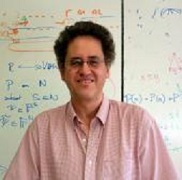A harmonograph is a drawing machine powered by pendulums. It was first invented in the 1840s – the heyday of the industrial revolution, who sensibilities are now celebrated by the “Steampunk” movement.
In this presentation, artist Anita Chowdry will recount her fascinating journey into this era, culminating in her creation of a two-meter high harmonograph crafted from brass and steel: “The Iron Genie”. Then, using computer simulations, mathematical physicist John Baez will explore the underlying mathematics of the harmonograph, taking us on a trip into the fourth dimension and beyond. As time passes, the motion of the harmonograph traces out a curve in a multi-dimensional space. The picture it draws is just the two-dimensional “shadow” of this curve.
This presentation will be enhanced by the creative output of a four-day workshop with University of Waterloo students at the department of Fine Arts, led by Anita Chowdry.
John Baez

John Baez was educated at Princeton and M.I.T. Now he is a professor of mathematics at U.C. Riverside, and in summers he works at the Centre for Quantum Technologies, in Singapore. Until recently he worked on higher category theory and quantum gravity. His internet column 'This Week's Finds' dates back to to 1993 and is sometimes called the world's first blog. In 2010, concerned about climate change and the future of the planet, he switched to working on more practical topics and started the Azimuth Project, an international collaboration to create a focal point for scientists and engineers interested in saving the planet.
Anita Chowdry

Anita Chowdry, Artist (London, UK) Anita Chowdry is a London-based visual artist, researcher and educator whose work is inspired by mathematics, geometry, and the book arts of the Islamic world. She is interested in the history of practical science and technology, and how it has shaped the arts and our aesthetic sensibilities. Her work is underpinned by an engagement with process and materials, and includes metalwork, etching, drawing, painting and mineral and metal-based pigments. The “Iron Genie” harmonograph project was developed between 2012 – 13 for Anita’s MA in Art & Science at Central Saint Martin’s, UAL. The Iron Genie has since toured institutions in the UK., including The Museum of the History of Science Oxford, and Dulwich Picture Gallery as part of a major retrospective of the work of M.C. Escher in London.
St. Jerome's University
University of Waterloo, Faculty of Arts
University of Waterloo, Faculty of Mathematics
Fields Institute